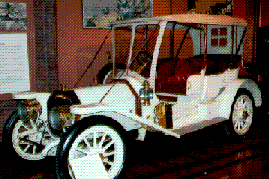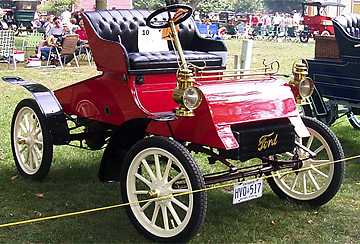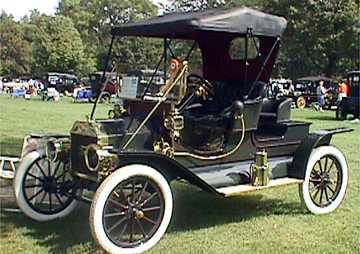In 1900 more
than 2,300 automobiles were registered in New York City; Boston, Massachusetts;
and Chicago, Illinois. Of these, 1,170 were steam cars, 800 were
electric cars, and only 400 were gasoline cars. Gasoline powered engines
eventually became the nearly universal choice for automobiles because they
allowed longer trips and faster speeds than engines powered by steam or
electricity. But development of gasoline cars in the early 1900s was hindered
in the United States by legal battles over a patent held by a New York
lawyer, George B. Selden. Selden saw a gasoline engine at the Philadelphia
Centennial Exposition in 1876. He then designed a similar one and obtained
a broad patent that for many years was interpreted to apply to all gasoline
engines for automobiles. Although Selden did not manufacture engines or
automobiles, he collected royalties from those who did. Henry Ford believed
Selden's patent was invalid. Selden sued when Ford refused to pay royalties
for Ford manufactured engines. After eight years of court battles, the
courts ruled in 1911 that Selden's patent applied only to two-stroke engines.
Ford and most other manufacturers were using four-stroke engines, so Selden
could not charge them royalties.
Improvements
in the operating and riding qualities of gasoline automobiles developed
quickly after 1900. The 1902 Locomobile was the first American car with
a four-cylinder, water-cooled, front mounted gasoline engine, very similar
in design to most cars today. Built-in baggage compartments appeared in
1906, along with weather resistant tops and side curtains. An electric
self-starter was introduced in 1911 to replace the hand crank used to start
the engine turning. Electric headlights were introduced at about the same
time.

This is a 1909 Locomobile.
This time period also marks an evolution
of style. Until this time the automobile looked largely like a horseless
carriage, the cars of this time period began to take on a style all their
own. In these new models, a hood covered the front-mounted engine. In these
new models, a hood covered the front-mounted engine. Cars had fenders that
covered the wheels and step-up platforms called running boards, which helped
passengers get in and out of the vehicle. The passenger compartment was
behind the engine. This was also the beginning of the left-hand drive vehicle,
although most horse-drawn and European vehicles were controlled from the
right side, American steering wheels were placed on the left.
In 1903 Henry Ford incorporated the Ford Motor Company, which introduced its first automobile, the Model A, in that same year. It closely resembled the 1903 Cadillac, which was hardly surprising since Ford had designed cars the previous year for the Cadillac Motor Car Company. Ford's company rolled out new car models each year, and each model was named with a letter of the alphabet. By 1907, when models R and S appeared, Ford's share of the domestic automobile market had soared to 35 percent.

Ford's famous Model T debuted in 1908 but was called a 1909 Ford. Ford built 17,771 Model T's and offered nine body styles. Known as the Tin Lizzy, Ford sold more than 15 million before stopping production in 1927, making the Model T one of the biggest selling automobiles of all time. Henery Ford was the first Automotive manufacturer to use the assembly-line style of production that was later widely adopted by the industry.

This is a 1909 Ford Model T.
By 1920 more than 8 million Americans owned cars. Major reasons for the
surge in automobile ownership were Ford's Model T, the assembly-line method
of building it, and the affordability of cars for the ordinary wage earner.Improvements
in engine-powered cars during the 1920s contributed to their popularity:
synchromesh transmissions for easier gear shifting; four-wheel hydraulic
brake systems; improved carburetors; shatterproof glass; balloon tires;
heaters; and mechanically operated windshield wipers.